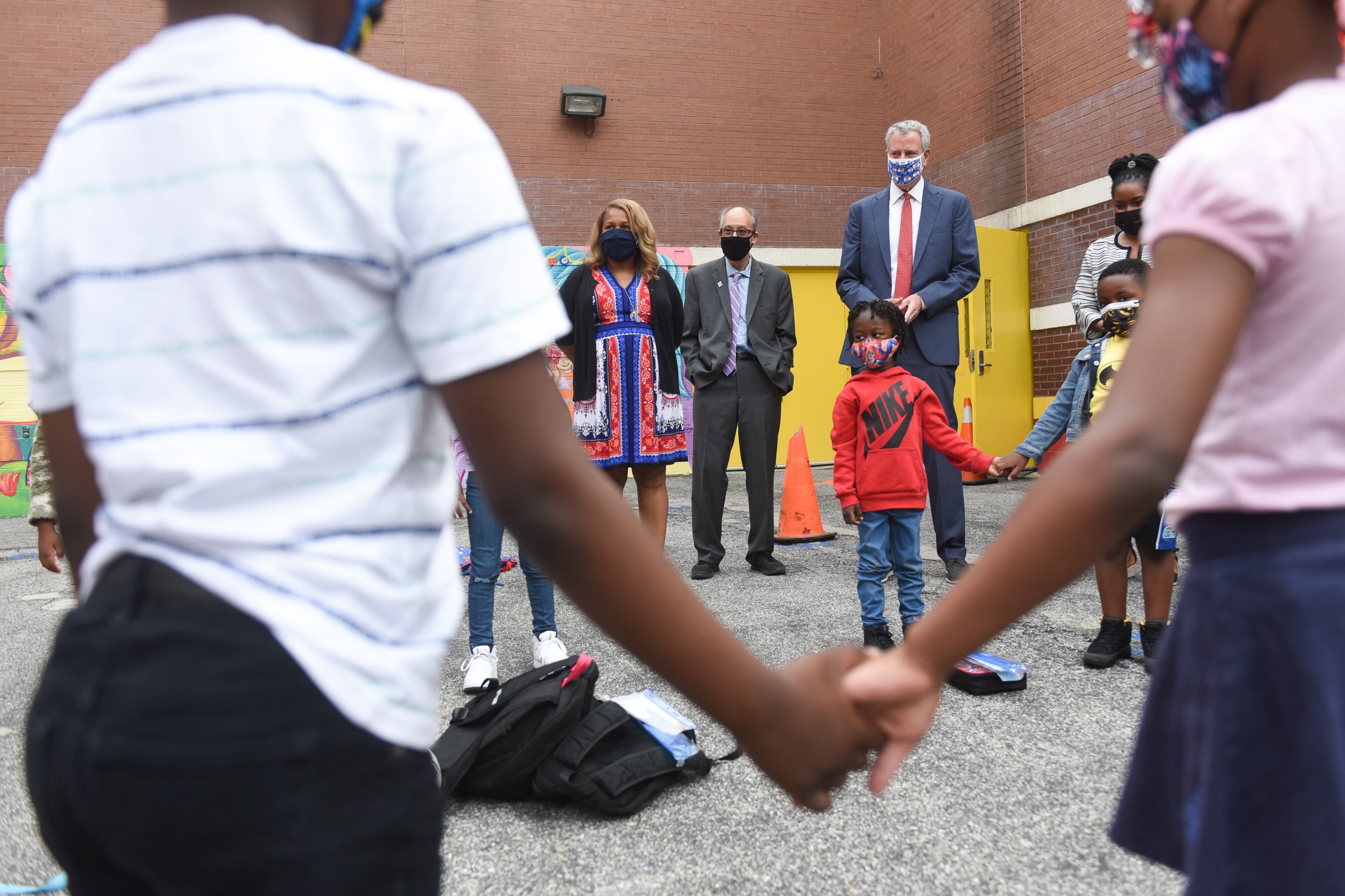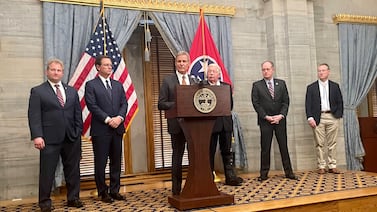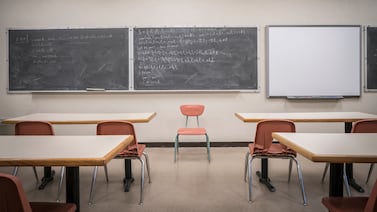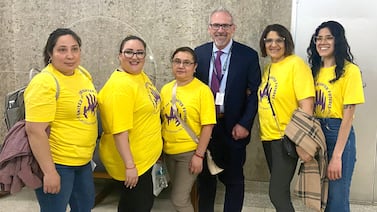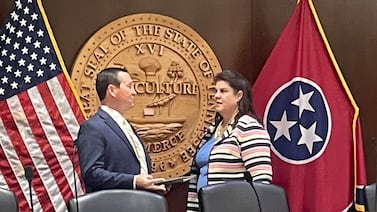New York City will infuse public schools with $635 million for an academic recovery plan that includes a universal literacy screening through second grade, after-school help for students with disabilities, and college counseling services for all juniors and seniors, Mayor Bill de Blasio and Schools Chancellor Meisha Porter announced Thursday.
The announcement provided long-awaited details on how some of the influx of federal stimulus money — expected to total $6.9 billion over three years— will be used to support the city’s nearly 1 million students and close what the mayor has called “the COVID achievement gap.” A main focus will be on literacy, including extra coaches and interventions, class size reductions at certain schools, and even the books that students read. As part of a new universal curriculum, called Mosaic, that the city plans to roll out in 2023, classroom libraries are expected this fall to begin getting 9 million new books that reflect the diversity of children in the nation’s largest school system.
“We’re going to jumpstart each child’s educational comeback,” de Blasio said, reiterating his years-long promise to have every child reading on grade level by third grade. He had previously pledged that by 2026 all children would be reading on grade level by the end of second grade.
Michael Mulgrew, president of the United Federation of Teachers, spoke at the press conference in support of the city’s plan, saying that people will be working this summer to ensure schools have the resources and training they need to carry it out.
“We know that there’s a lot to do here, but this is what we signed on for,” Mulgrew said. “Now we just have to make it work for each and every child in every classroom.”
De Blasio had previously said the academic recovery program would include personalized online tools for children after school as well as assessments given to children in the fall. Neither of those were part of Thursday’s announcement. Education department officials said that schools will indeed assess children as a way to supplement the newly unveiled plan, but this would be funded separately.
The chancellor made a point to say that English language learners — about 135,000 students in the city’s public school system — will receive “dedicated supports” as part of the academic recovery plan.
An education department spokesperson said schools would get the funding “soon,” with literacy coaches and other intervention staff in place on Sept. 13.
Here are some of the plan’s highlights:
Special education: $251 million
Noting that the pandemic had a disproportionate impact on students with disabilities, Porter said the city will launch after-school and Saturday programs for the more than 200,000 students with individualized education programs, or IEPs. Through this funding, students will also be able to do their related services, such as speech and occupational therapy after school, officials said.
Porter also said 800 additional special education pre-kindergarten seats will be in place by September 2022, as the city has historically not provided a seat for every student with a disability who is entitled to one. At the end of the 2019-2020 school year, 1,215 preschool students with disabilities were still waiting for classroom seats.
During the pandemic, the education department struggled to provide students with disabilities with the services they are entitled to receive. According to a report released in February, nearly a quarter of students with disabilities were not receiving mandated special services, which might include smaller class sizes or other specialized support, and other services like physical therapy were often difficult to deliver remotely.
The city has previously said it planned to spend roughly $236 million on make-up services to compensate for lost time during the pandemic. This is now part of the plan announced Thursday.
Still, Advocates for Children of New York Executive Director Kim Sweet wanted to know more about how the city will address the lapse in services for these students.
“We are still waiting for the DOE to release a plan for make-up special education services for students with disabilities without requiring each individual family to request and litigate an administrative hearing, which can take months and sometimes years,” Sweet said in a statement.
By including compensatory services in this plan, the goal is that parents would not need to make a request or file for a hearing, education officials said.
Universal Mosaic curriculum: $202 million
More than $200 million will be invested in creating and sustaining a universal culturally responsive curriculum designed by New York City educators. The comprehensive curriculum, which is slated to be ready for schools to implement by the fall of 2023, is designed to reflect the diversity of the city and will include support materials for English and math, officials said.
This announcement comes one week after the City Council announced a $10 million “education equity action plan” to create a K-12 Black Studies curriculum. That funding includes professional development for educators to support the implementation of the curriculum and was included in the city’s $98.7 billion spending plan.
“I’m excited to ensure that every student is welcomed into an affirming, supportive, and rigorous learning environment where they see themselves in the curriculum, where we honor the voices of our students and families,” Porter said.
The Mosaic curriculum, which covers English and math, would be mandated, unless a school gets a waiver to use an existing curriculum, officials said. “This isn’t about a mandate. It’s about a collaborative process,” the chancellor said, emphasizing that the curriculum will be made in partnership with educators.
The teachers union president seemed to be on board with the “massive project” of creating the new curriculum.
“Teachers have scrambled for decades trying to find these materials,” Mulgrew said. “What we’re saying here is that the school system is taking on the role and responsibility of bringing all these materials together that represent all of the different children and populations and cultures that we teach, and making them available so that the schools don’t have to scramble over and find them on their own. It is absolutely the smart thing to do.”
Parents for the NYC Coalition for Education Justice, which has long advocated for a culturally responsive curriculum, said they were excited about the new curriculum.
“All students, educators, school workers and families will learn collectively about their own cultures and other cultures,” said Rasheedah Brown-Harris, a parent leader in the Alliance for Quality Education, which is part of the coalition. “This will truly support our healing practices building our understanding, appreciation, pride and respect for each other.”
Students as digital citizens: $122 million
The COVID pandemic exposed digital divides in New York City, as nearly 60% percent of students were learning remotely through the end of the school year. Nearly one-fifth of New York City students lack home and mobile broadband services, and 40% of students have only one or the other, according to the internet master plan released last year.
During the pandemic, the city invested in about 800,000 devices for remote learning. The academic recovery plan calls for investing in an additional 175,000 devices, ensuring all students have access to a device with internet access. Eighth grade students will also be required to complete a tech capstone project to make sure they have developed computer skills.
“This plan will position all New York City students as digital citizens in today’s world,” the chancellor said.
The plan also expands the Computer Science 4 All initiative to 400,000 students by 2024. More than 5,000 educators will be trained in advanced computer science.
Literacy for all: $49 million
To ensure students are reading at grade level by third grade, educators will use a universal literacy screen to identify students with challenges, including print-based disabilities such as dyslexia. The number of reading coaches will also increase to 500, which the chancellor said would ensure every classroom from 3-K through second grade would have a reading coach. School officials said there would be additional funds to provide targeted support, such as tutoring, extended day and enrichment activities.
“This is going to be the year of the literacy blitz,” Porter said. “Our educators will use a universal literacy screen to identify students’ strengths and challenges, including dyslexia, and make a support plan. Too many of our kids have struggled with print-based disabilities like dyslexia. And this is not okay.”
The city has long struggled to serve students with dyslexia and other reading challenges, leading some families to move their children to private schools and sue the city for reimbursement. The city has previously experimented with dyslexia screening on a small scale; dozens of other states mandate some level of screening to identify struggling readers.
Porter also said that class sizes at certain schools would be reduced. Approximately 140 additional teachers will be hired and specifically deployed to the 72 elementary schools with the largest class sizes, targeting areas with low English proficiency rates.
Nearly half of third graders in New York City public schools are not reading at grade level, according to state test scores, and expanding literacy has been a cornerstone of de Blasio’s education agenda. The mayor’s Universal Literacy program has already placed hundreds of literacy coaches across the city’s elementary schools to train teachers in phonics-based instruction.
This year’s interventions will include programs that support word recognition skills as well as “research-informed methodologies” that support vocabulary and reading comprehension, school officials said. They did not immediately say what the timeline would be for the students to get support or how long it might take for schools to identify students’ needs.
College and career readiness: $10 million
To help keep students focused on what’s next after graduation, the city will provide all juniors and seniors with free after-school college and career counseling, along with college financial aid guidance in multiple languages to help navigate the application process, according to officials.
“Especially as our students heal from the pandemic, we need to make sure they are better prepared for the next steps in life,” Porter said.
The city also plans to add dozens of virtual Advanced Placement courses and restore the “College Now” program, enabling thousands of students to take courses at 18 City University of New York campuses across the boroughs.
Alex Zimmerman contributed.
Correction: Based on incorrect information from the education department, an earlier version of this story said that compensatory services for students with disabilities were separate from this plan. They are included in it.


